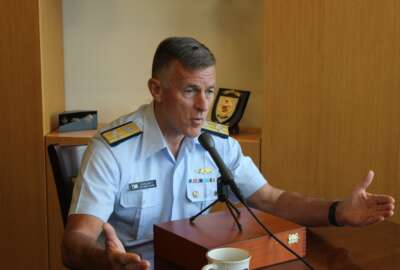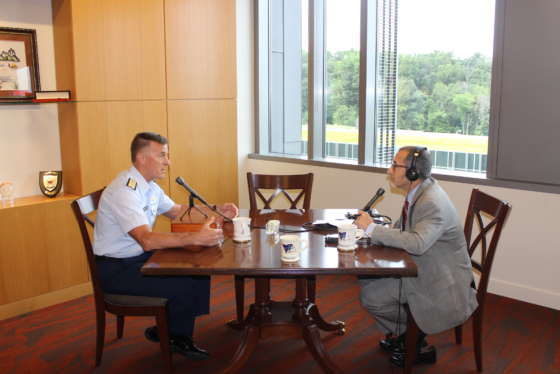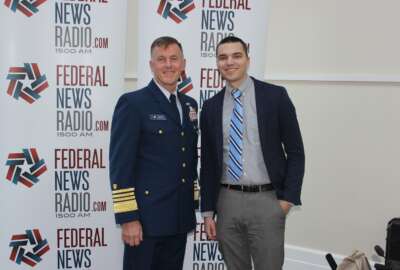
Workforce focus, fleet upgrades propel Coast Guard toward modernization
High retention rates and fleet upgrades are allowing the service to accomplish its mission to new degrees.
The Coast Guard is evolving to meet the challenges of the 21st century. New workforce policies, high retention rates and fleet upgrades are allowing the service to project far beyond the coasts of the United States and accomplish its mission to new degrees, but it still has budgetary challenges to contend with.
One of the highest priorities the Coast Guard is focusing on is its workforce. Adm. Paul Zukunft, commandant of the Coast Guard, said on DHS 15th Anniversary that the service enjoys the highest retention rate of all the military services.
“Forty percent of the recruits that will come out of Cape May, New Jersey will be on active duty 20 years from now. Sixty percent of the officers that we commission up in New London, Connecticut will be on active duty 20 years from now,” he told the Federal Drive with Tom Temin. “We make tremendous investments in these individuals, but if they then leave and walk out the door, we never get to that next level where they truly become professionals at what they do, and we continue to operate with journeymen. So as long as we continue to enjoy these high retention rates, we will be well-served. But I cannot assume that we are going to enjoy these unprecedented retention rates.”
That’s why the Coast Guard is laying out new workforce priorities reminiscent of former Secretary of Defense Ash Carter’s Force of the Future strategy to incentivize sailors to stay in the service.
“We actually put out a human capital strategy for the 21st century to address things like dual careers and child care, and the number of times we move, incentive packages,” Zukunft said. “Now, on top of that, we’re folding in a new retirement system, as are all the armed services, and how do we accommodate that as well? If you don’t look out for your people, you can build all these new ships, and new planes, but if you’re not keeping an eye on your people, they will be tied to the pier and will not be able to be put out to sea.”
And the Coast Guard does have some new ships that it doesn’t want to see tied to the pier anytime soon. Its new national security cutters are changing the way the service performs drug interdiction.
“We’re at the point now that a national security cutter, on its maiden voyage, literally pays for itself, if you will, and then usually one-and-a-half times over in the value of illicit drugs that it removes in one deployment,” Zukunft said. “And these ships will be around for 30-plus years. The technology that goes into these ships, our ability to exploit and initiate intelligence on transnational criminal organizations is a huge game-changer for us as well. That’s why you see these ships coming back to San Diego or Cape Canaveral with an entire flight deck with pallet after pallet of cocaine from just one deployment.”
There was a bit of a learning curve, he said, when it came to operating these newer ships. The Coast Guard had been used to a fleet that was around 50 years old. But the newer ships have upgraded engines that are meant to operate at higher RPMs than the older diesels, and thus don’t idle well. This resulted in the new ships having to be towed back into port occasionally.
But now the Coast Guard has a handle on its newer ships, and is putting the new technologies to good use, like the intelligence capabilities. Zukunft said that those, plus new synergies with other components of the Department of Homeland Security, like Immigration and Customs Enforcement and Customs and Border Protection, as well as the national intelligence community, have helped the Coast Guard develop more targeted strategies for interdiction, as opposed to its older strategy of patrolling and hoping it stumbled across something.
“When I came into this job a little over three years ago, the first thing I said was ‘we’re going to have intel drive where we operate. Now, intel also drives where we’re not operating. You don’t have infinite resources. You’re constrained,” he said. “But we have information, and we’re staffed with members of the national intelligence community to have awareness of over 80 percent of maritime drug flow that is on the waters in the Pacific and in the Caribbean. But back in 2014, on the best of days, we could maybe target 10 percent of that 80 percent.”
Between the upgraded capabilities and the better intelligence, Zukunft said the Coast Guard’s deployments are far more action-packed than they used to be.
“Now, we know where the threat is at, and you are running at full speed to interdict it,” Zukunft said. “We’ve taken most of the guesswork out of it, so to be deployed, when you talk to these crews coming back, some of them are counting down the days until they can get back there and go again. I would liken it to going fishing, and it’s a feeding frenzy. You have to go in, and filet your fish and sell them. You can’t wait to go back and catch some more. That’s kind of how our crews are operating today.”
He said that last year, the Coast Guard set a record for the amount of cocaine seized from drug runners, and is on pace to break the record again this year.
Another area where the Coast Guard is looking to improve its capabilities is drones.
“We are long overdue to get into the world of land-based, long-range unmanned aerial platforms to operate in the maritime domain,” he said. “We’re doing that right now with ship-based systems that are quite stealthy, and they’ve been very effective.”
Zukunft said that before the Coast Guard started using drones, it was easy for criminals to spot the big white ships with orange helicopters appearing on the horizon. But now, the Coast Guard can perform better reconnaissance without being seen. He said recently, they were able to use a ship-based drone to track a refueling ship for 36 hours. When the smaller smuggling ship finally appeared to refuel, the Coast Guard launched a heavily armed helicopter that was able to disable it before the ship moved in to reveal itself.
Now the service is looking into using the land-based systems outside of the continental U.S. to increase those intelligence and reconnaissance capabilities even more. Zukunft said they would be used in places like Ecuador, a major partner of the Coast Guard when it comes to drug interdiction.
It also just awarded phase two of a contract for 58 fast response cutters, is expecting the first of its offshore patrol cutters in 2021, and is shopping around for a shipyard to build a fleet of six new icebreakers to increase the U.S. presence in the Arctic.
“These are truly a quantum leap above their predecessors in terms of the capability that they bring,” he said.
But the service still faces budget issues. Zukunft said Congress hasn’t provided the kind of funding he needs to maintain the full scope of operations.
“When I go to the Hill, I talk about how I need 5 percent growth in my operating pace, because for five years running now, we find ourselves in our fifth consecutive year funded below the budget control act,” he said. “I’m a military service. If you were to tell anyone of my other service chief counterparts that you were going to be funded for the next five years below the Budget Control Act, yet you still have a job to do, some of that work would have to stop. So the area where we start incurring some degree of risk is on the maintenance side. And once you go down that slippery slope, you may have to lay up or take a ship out of service. So it’s a very delicate balance. But as a military service, we need to be funded like a military service.”
Copyright © 2025 Federal News Network. All rights reserved. This website is not intended for users located within the European Economic Area.
Daisy Thornton is Federal News Network’s digital managing editor. In addition to her editing responsibilities, she covers federal management, workforce and technology issues. She is also the commentary editor; email her your letters to the editor and pitches for contributed bylines.
Follow @dthorntonWFED






